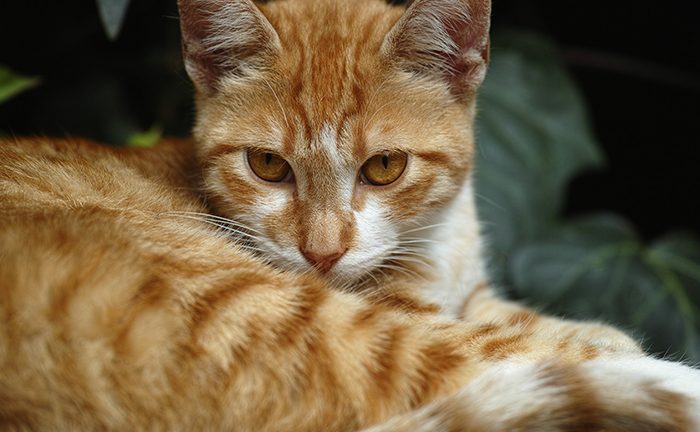This article original appeared on saveacat.org and is being reposted here in an effort to share and spread truth and knowledge.
Debunking the Myths and Misinformation: Cat Predation
Cats are being blamed for the decline in bird populations and other wildlife, and depicted as enemies of the environment. Just as cats were hunted during the late Middle Ages under falsified pretenses, bird conservancy groups and wildlife organizations, like the American Bird Conservancy (ABC), the National Audubon Society, and the National Fish and Wildlife Service (NFWS), are creating a “witch-hunt” for modern times. The information these organizations are providing on cat predation and the effect cats have on the environment is beset with errors, exaggerations, glaring omissions, and inexcusable bias — as is most of what passes for “research” on this issue.
The research and data these organizations offer can be traced back to a handful of deeply flawed studies that have become the “holy grail” of statistics. Not to mention, they completely ignore statistical information regarding the effectiveness of Trap-Neuter-Return (TNR), which has been gathered by countless highly accredited veterinarians and cat organizations through years of research and rescue. The relationship between cat predation and prey populations is highly complex and very little research has been conducted on this hot topic. For conservationists to advocate for the killing of a species based on a lack of information and misinformation is irresponsible and unethical. In this factsheet, we will expose this “bad science” that organizations continue to promote as evidence for the justification of killing cats.
Infamous Studies and Extrapolated Numbers
It cannot be emphasized enough that few scientific studies have been conducted to accurately portray cat predation on prey populations. Most studies have been performed on the dietary habits of cats, with little research dedicated to the overall effects of predation. And some of these studies are based on flawed, unpublished information with small sample sizes, poor data gathering techniques, and results that are being extrapolated across continents and different types of environments.
One of the most infamous studies highlighted by conservationists to falsely accuse cats of killing billions of birds every year was conducted by Peter Churcher and John Lawton; the study has become known as the “English Village” study. Churcher asked his neighbors to collect any prey their cats brought home, and over the course of a year, 70 cats returned home with over 1,000 prey specimen. These findings were then extrapolated across all of Britain, based on the cat population at the time, and it was derived that cats in Britain were killing an estimated 100 million birds and small mammals each year (Tabor, 1991).
In analyzing this study, one can see some of its glaring mistakes. First, this study is based on a very small sample size — 70 cats over a period of one year. Secondly, recording the number of prey brought home by cats is not a very accurate method of collecting data. As we have seen, cats are known to scavenge and eat carrion, so simply bringing prey home is not indicative of the number of prey actually killed by the cats. Also, cats do not always bring every prey item back home, and the data is based on the fact that all cat guardians collected every prey specimen brought home. A lot of variables were at play in collecting data for this study, so how accurate can one say the results are?
Another error in conservationists citing this study is the extrapolation of data across an entire country. Roger Tabor examines this study in his 1991 book, “Cats: The Rise of the Cat,” and says, “It is not realistic just to multiply the number of catches of these [70] rural cats by the entire cat population of Britain. Most cats are town cats with small ranges, and catch fewer items of prey than the village cats of this survey.” Tabor continues on to explain that even though a high number of house sparrows were consumed by cats, their population doubled the following breeding season, and because most people assist birds (feeders, nesting boxes), their populations are “kept at well above ‘natural’ levels. Even if there are a lot of cats in built-up areas, there are also a lot of birds” (Tabor, 1991).
In 1994, a reporter for the Sonoma County Independent, Jeff Elliott, investigated the growing claim that cats are responsible for killing millions of birds and the push for eradicating cats. In his article, “The Accused,” Elliott remarked on the infamous English Village study saying, “Rarely are projections made with such limited data, except in junior high science projects.” Later in 1995, Churcher himself cautioned against such projections stating, “I’d be very wary about extrapolating our results even for the rest of Britain, let alone America.” He continued by saying, “I don’t really go along with the idea of cats being a threat to wildlife. If the cats weren’t there, something else would be killing the sparrows or otherwise preventing them from breeding” (Tufts, 1995).
Another study that is often presented as “evidence” by conservationists is the “Wisconsin Study,” performed by John Coleman and Stanley Temple. The study is a survey of rural residents of Wisconsin performed to estimate the number of free-ranging cats living in the entire state. The results from this survey were published in the Wildlife Society Bulletin, where submissions are subject to a peer-review process. This survey in no way measures cat predation, but only estimates the number of cats in Wisconsin.
Subsequently, the authors published several additional articles in an attempt to predict the potential impact of free-ranging cats on the bird population in Wisconsin; however, these articles were never peer-reviewed and some of the estimates are based on unpublished data. One such article appeared in 1996, in the Wisconsin Natural Resources Magazine, where Coleman and Temple make their “best guesses” (as referred to by the researchers themselves) of the number of birds killed by cats in rural Wisconsin. They concluded: 7.8 million birds as the low estimate, 38.7 million as the intermediate estimate, and 219 million birds each year for the highest estimate. In 1999, the authors published another article in Wildlife Control Technologies, extrapolating those guesses yet again stating, “Nationwide, rural cats probably kill over a billion small mammals and hundreds of millions of birds each year” (Coleman et. al, 1999).
It wasn’t until Jeff Elliott interviewed Temple that the truth was revealed. “The media has had a field day with this since we started. Those figures were from our proposal. They aren’t actual data; that was just our projection to show how bad it might be,” replied Temple (Elliott, 1994). Yet, almost 20 years later, these exaggerated and “guesstimated” numbers are still being used and they are becoming more and more accepted as fact.
Sticky Numbers
Peter J. Wolf, the voice behind Vox Felina, examines just how these sticky statistics have come to be viewed as actual data. In his 2010 blog post, “Repeat after Me,” Wolf recalls a National Public Radio broadcast where Wall Street Journal columnist Carl Bialik describes the process whereby such slippery figures gain traction:
An interesting phenomenon of these numbers is that they’ll often be cited to an agency or some government body, and then a study will pick it up, and then the press will repeat it from that study. And then once it appears in the press, public officials will repeat it again, and now it’s become an official number.
Unfortunately, this is exactly what has happened with the data from both the English Village study and the Wisconsin study. Along with major newspapers, such as the New York Times, the Los Angeles Times, and the Wall Street Journal, conservation organizations like ABC, the National Audubon Society, and the NFWS continue to repeat these sticky numbers as solid evidence.
Roger Tabor addressed this concern in regards to the English Village study saying, “The mesmeric effect of big numbers seems to have stultified reason” (Tabor, 1991). And Gary J. Patronek, VMD, Ph.D. of Tufts University said this about cat predation statistics in a letter to the editor of the Journal of Veterinary Medicine (1996):
If the real objection to managed colonies is that it is unethical to put cats in a situation where they could potentially kill any wild creature, then the ethical issue should be debated on its own merits without burdening the discussion with highly speculative numerical estimates for either wildlife mortality or cat predation. Whittling down guesses or extrapolations from limited observations by a factor of 10 or even 100 does not make these estimates any more credible, and the fact that they are the best available data is not sufficient to justify their use when the consequences may be extermination for cats.
If asking for reasonable data to support the general assertion that wildlife mortality across the United States attributable to cat predation is unacceptably high can be construed as ‘attempting to minimize the impact,’ then I am guilty as charged. What I find inconsistent in an otherwise scientific debate about biodiversity is how indictment of cats has been pursued almost in spite of the evidence.
As demonstrated here, it is very easy for a small scientifically valid, peer-reviewed study to be manipulated — thanks to the media and anti-cat groups — into a much larger, broader statement which is being used to push an agenda to kill cats.
Conclusion
The few cat predation studies that have been carried out on continents have resulted in countless biologists stating that:
* Cats are no more harmful a predator than any other predator;
* Cats have been a part of the landscape for thousands of years, therefore birds and wildlife who could not withstand such predation from cats would have died off long ago;
* Human activity is more devastating to birds and wildlife than any cat predation.
Unfortunately, conservationists continue to cherry-pick studies, citing unpublished, unreviewed data and guesses as reliable, scientific research in order to falsely accuse outdoor cats for declining bird and wildlife populations.
In March 2013, George Fenwick, president of ABC, clearly stated his position on outdoor cats and TNR programs, when he wrote in a Baltimore Sun opinion piece called, “House Cats: The Destructive Invasive Species Purring on Your Lap:”
The only sure way to protect wildlife, cats and people is for domestic cats to be permanently removed from the outdoor environment. Trap-neuter-release programs that perpetuate the slaughter of wildlife and encourage the dumping of unwanted cats is a failed strategy being implemented across the United States without any consideration for environmental, human health, or animal welfare effects. It can no longer be tolerated.
Local governments need to act swiftly and decisively to gather the 30 million to 80 million unowned cats, aggressively seek adoptions, and establish sanctuaries for or euthanize those cats that are not adoptable.
Dr. Julie Levy from the University of Florida’s Veterinary School and cofounder of Operation Catnip was quoted in Best Friends magazine (2003) as stating, “There are much more important pressures on bird populations [than cats] ─ primarily pollution and habitat destruction. And those are harder areas for bird groups to be effective in.” Levy said:
The problem is that part of the campaign is an attack on humane control of homeless or feral cats. Most of us love song-birds as much as we love cats, so we are not trying to choose one species over another. We’re trying to come up with a solution that benefits everybody in the picture.
Levy concludes that the goal is to reduce the feral cat population saying, “we can do it in a humane way that respects the animals rather than in a 50-year-old vision of animal control, in which the only way you can help animals is by killing them” (Best Friends, 2003).
Alley Cat Rescue agrees that outdoor cat populations need to be controlled. But we also believe that because nonlethal methods exist and work, they should be used. This seemingly attractive “quick fix” of killing does not work. Never has and never will. And more importantly, eradication will cause even more devastation to birds if these conservation groups ever convince the U.S. government to agree to such a plan.
For too long cats have received a bad rap and been blamed for the destruction of birds and wildlife. It is time for conservation groups to stop using exaggerated numbers and bogus studies to base these claims upon. Yes, some cats kill birds, but for agencies, especially government supported ones, to push for the eradication of cats based on such falsehoods and deception is horrifying and tragic … and it could have devastating consequences. Removing all outdoor cats — a mesopredator and a highly specialized rodent hunter — would be an unimaginable disaster for the American environment.
References
Tabor, Roger. Cats: The Rise of the Cat. London, England: BBC Books, 1991. Print.
Elliott, Jeff. “The Accused.” The Sonoma County Independent 3 Mar. 1994: 1 & 10. Print.
Tufts University School of Veterinary Medicine. “What the Cat Dragged In.” Catnip 1995: 4–6. Print.
Coleman, John S., and Stanley A. Temple. “On the prowl.” Wisconsin Natural Resources, December 1996. Web. 3 Mar. 2015.
Coleman, John, S., Stanley A. Temple, and Scott R. Craven. “Cats & Wildlife: A Conservation Dilemma.” Wildlife Control Technologies 1999: 18–20. Print.
Wolf, Peter J. “Repeat After Me.” Vox Felina. N.p., 3 Aug. 2010. Blog. 1 Mar. 2015.
Patronek, Gary J. “Letter to the Editor.” Journal of the American Veterinary Medical Association 209.10 (1996): 168687. Print.
Fenwick, George. “House Cats: The Destructive Invasive Species Purring on Your Lap.” Baltimore Sun 25
Feb. 2013. Web. 1 Mar. 2015.
Best Friends Animal Society. “Pussycats or Predators?: The Feral Catfight.” Best Friends, 2003. Print.













Add comment